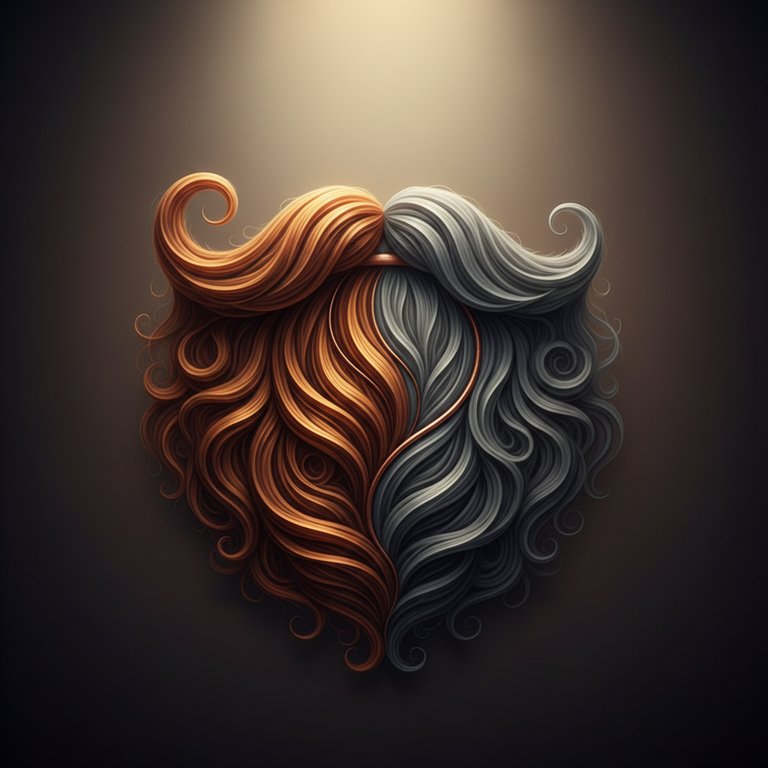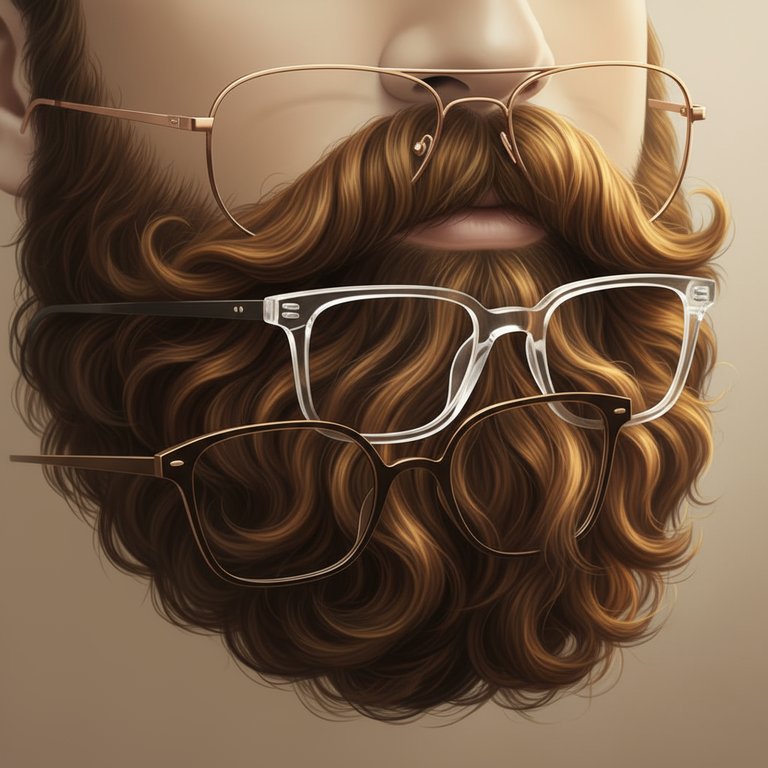Hey there, beard fam! Ever caught yourself staring in the mirror, wondering why one side of your glorious facial hair seems to be running a marathon while the other is still doing warm-ups? You're not alone! It's a super common beard mystery that many of us face (pun intended!). Today, we're diving deep into why your beard might be playing favorites and what you can do about it. No need to stress, we're going to unravel this hairy enigma together, just like good friends figuring things out.
Understanding the "Why": It's Often About Genetics (and a Little Bit More!)
Let's get real right off the bat: the biggest player in the uneven beard game is often your genetics. Yep, your DNA pretty much calls the shots when it comes to how your hair grows, where it grows, and even how fast. Think of it like this: your hair follicles, those tiny little factories producing each strand of hair, are programmed by your unique genetic code. And just like your eyebrows are rarely perfectly symmetrical, your beard can have its own little quirks.
Each hair follicle goes through a growth cycle – growing, resting, and shedding. It's totally normal for these cycles to vary slightly from one side of your face to the other. So, one side might have more follicles in the active growth phase (anagen) at any given time, making it appear to grow faster or fuller.
The Sneaky Role of Hormones (Without Getting Technical)
While we're not diving into medical textbooks here, it's worth a quick mention that hormones, particularly testosterone and dihydrotestosterone (DHT), play a significant role in facial hair growth. Your body's response to these hormones, and even their distribution, can be subtly uneven across your face. Again, this isn't something you can easily control or measure at home, but it's another natural factor contributing to your beard's unique personality. The best approach here is to focus on general well-being, which supports overall hair health.
Lifestyle Habits That Might Be Contributing
Sometimes, the culprit isn't deep within your DNA, but rather in your daily routine. These habits might seem small, but over time, they can make a noticeable difference:
- Sleep Position: Ever thought about how you sleep? If you consistently sleep on one side, that constant friction against your pillow can actually rub away at your beard hairs, potentially slowing growth or causing breakage on that side. It's like a tiny, nightly sandpaper effect!
- Touching or Pulling: Are you a beard fidgeter? Many of us unconsciously stroke, pull, or play with our beards, especially when thinking or stressed. If you tend to favor one side, that constant manipulation can stress the hair follicles and lead to breakage, making that side appear thinner or shorter.
- Leaning/Resting: Similar to sleeping, if you habitually rest your chin or cheek on your hand, or lean against surfaces (like a desk or car window) on one side, that continuous pressure and friction can also impact growth and hair health.
- Sun Exposure: While less common for a full, thick beard, uneven sun exposure could theoretically play a minor role, though its impact is usually less significant than other factors.
Grooming Goofs: Are You Trimming Unevenly?
This one is a biggie and often overlooked! It's incredibly easy to accidentally trim one side of your beard more than the other. Especially if you're new to beard grooming, rushing, or trimming in less-than-ideal lighting, you might be creating the unevenness yourself without even realizing it. Our dominant hand often makes us more confident (and sometimes overzealous) on one side. Plus, mirrors can play tricks, distorting your perception of symmetry. This is a super common reason for a perceived "faster growing" side.
Step-by-Step Guide: Taming the Uneven Beast
Alright, so you've identified the issue. Now what? Don't despair! Here's a friendly, step-by-step approach to help manage and balance your beard growth:
1. Observe and Identify
Before you grab any tools, take a few days to really look at your beard. Is one side truly growing faster, or is it just thinner, sparser, or perhaps growing in a different direction? Take some photos from different angles (front, left, right) over a few days. This can help you see what's really going on without the mirror's potentially distorting effect. Understanding the actual issue is the first step to fixing it.
2. The "Grow It Out" Strategy
For most guys, the best initial strategy is to simply let it grow. Resist the urge to immediately trim the longer side to match the shorter one. This can lead to an endless cycle of trimming and a perpetually shorter beard. Give both sides ample time – aim for at least 2-3 months of minimal trimming – to really develop. Often, the "shorter" side will catch up, or the longer hairs from the fuller side can be trained to cover sparser areas.
3. Strategic Trimming (When the Time is Right)
Once you have some decent length, and the shorter side has had a chance to catch up a bit, you can start shaping. When you do trim:
- Use a good quality beard comb and sharp scissors or a trimmer with a guard.
- Always start with the longer, fuller side, trimming in tiny increments. Take less off than you think you need.
- Comb the hair outwards, then downwards, and look for any stray hairs or areas that stick out.
- Use a mirror and excellent lighting. Step back frequently to assess symmetry from different angles.
- Consider using a beard shaping tool or template if you struggle with freehand symmetry.
4. Embrace Consistent Grooming
A well-groomed beard always looks better, and consistent care can help minimize the appearance of unevenness:
- Beard Oil and Balm: Apply these nourishing products evenly to both sides of your beard daily. They hydrate the hair, make it softer, reduce frizz, and can make the beard appear fuller and healthier.
- Combing and Brushing: Regular combing or brushing helps to detangle, distribute natural oils, and most importantly, trains your beard hair to grow in a desired direction. This can be super effective in guiding hairs from fuller areas to cover sparser spots.
- Washing and Conditioning: Use a dedicated beard wash and conditioner a few times a week. Clean, healthy hair is more manageable and looks its best.
Tips and Tricks for a More Harmonious Beard
- Patience is Your Best Friend: Seriously, growing a great beard takes time. Don't get discouraged if you don't see immediate results. Consistency is key.
- Healthy Lifestyle: While not a direct fix, a balanced diet, good hydration, and adequate sleep contribute to overall hair health. Your beard is part of you, after all!
- Mind Your Sleep Position: If you're a side sleeper, try to vary your position or invest in a silk or satin pillowcase. These reduce friction compared to cotton and can help prevent breakage.
- Hands Off (Mostly): Try to be mindful if you find yourself constantly touching, pulling, or twisting one side of your beard. Less manipulation means less stress on the hair.
- Learn Your Angles: When trimming or styling, pay attention to how your beard looks from all angles, not just straight on. What looks perfectly even in the front might need a slight adjustment from the side.
- Consider a Professional Trim (Eventually): If you've tried everything and are still struggling with symmetry, don't hesitate to visit a skilled barber. They have an eye for shape and can work wonders in balancing your beard.
FAQ Section: Your Burning Beard Questions Answered!
How can I make my beard grow thicker on one side?
While you can't force individual hair follicles to grow thicker or faster due to genetics, you can create the appearance of thickness and encourage healthy growth. Focus on letting both sides grow out fully without trimming for a few months. Use a good quality beard oil and balm to nourish the hair, making it softer and less prone to breakage, which can contribute to a fuller look. Regular brushing can also help distribute hairs evenly and train them to cover sparser areas, giving the impression of a more uniform and thicker beard.
Why does my beard look patchy even after months of growth?
Patchiness is super common, especially in the early stages of beard growth! It's usually down to genetics – some areas just have more hair follicles than others, or the follicles might be on different growth cycles. Patience is key here. Often, patches fill in as the surrounding hair grows longer and can be combed or brushed over the sparser areas. Keep your beard nourished with oil and balm, and brush regularly to encourage a uniform appearance. Give it time; many patchy beards eventually fill in beautifully.
What happens if I keep trimming the longer side of my beard to match the shorter side?
If you constantly trim the longer side to match the shorter side, you might find yourself in a perpetual cycle where your beard never really gains significant length. You'll essentially be "chasing" the shorter side, which can be frustrating and make your beard appear stuck at a certain length. It's often better to let the shorter side catch up, even if it means enduring a slightly uneven look for a few weeks, before attempting a trim to balance the overall shape. This approach allows for overall growth and a more substantial beard in the long run.
How long does it take for a noticeably uneven beard to balance out?
This really depends on the individual and the extent of the unevenness. If it's a minor difference, you might see it balance out in a few weeks with consistent grooming and allowing growth. If it's more significant, it could take 2-3 months or even longer of dedicated growth and minimal trimming. Remember, hair growth is a slow process, about half an inch per month on average. Patience and consistent care are your best allies here; your beard has its own timeline!
Can daily beard brushing help even out growth?
Absolutely! Daily beard brushing or combing is a fantastic practice. While it won't directly change your genetic growth pattern or speed up growth on one side, it can significantly help with the appearance of an even beard. Brushing helps to train the hairs to lie in a desired direction, distribute natural oils, detangle, and can help cover up sparser areas by spreading the longer hairs. It also stimulates the follicles, promoting healthy hair overall, which contributes to a more uniform and well-maintained look.
Conclusion
So there you have it, fellas! Uneven beard growth is a totally normal part of the beard journey for many of us. Whether it's your unique genetic blueprint, subtle lifestyle habits, or even an accidental trim, there are plenty of reasons why one side might be taking the lead. The good news is, with a little patience, consistent grooming, and the right approach, you can absolutely manage it and rock a fantastic, well-maintained beard. Remember, your beard tells your story, and a little character (even if it's slightly asymmetrical!) only adds to its charm. Keep growing, keep grooming, and most importantly, keep enjoying that magnificent facial hair!
Disclaimer: This blog post is intended for informational purposes only and is not a substitute for professional advice. Always consult with a qualified professional for any personal concerns.



